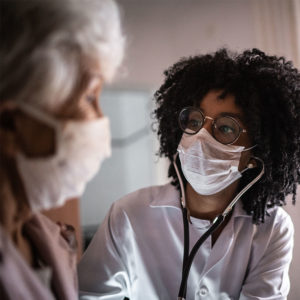Interventional Care


We notice that you are visiting us from . This site only services US-based visitors. Would you like to visit the site that is appropriate for your location?

From early in the pandemic, we watched as one nursing home after another began to experience infections, outbreaks, then deaths, from this highly transmissible virus. Long-term care (LTC) facilities scrambled to prevent and contain the virus from ravaging their residents, and the Centers for Disease Control and Prevention (CDC) had almost daily updates on prevention guidance specific to LTC. Now, over a year and a half into the pandemic, CDC has provided some recent updates to the guidance.
Older adults living in congregate settings are at an increased risk of being affected by respiratory pathogens, such as SARS-CoV-2, amongst other viral and bacterial threats.1 As long-term care facilities are beginning to resume normal activities, they will need to sustain the interventions implemented during the onset of the pandemic and remain vigilant regarding SARS-CoV-2 infection surveillance for both residents and staff.
To strengthen the infection prevention and control (IPC) foundation for nursing homes, the CDC continues to update the guidance for LTC facilities based on evolving data and science around COVID-19 transmission, infection, vaccination, and deaths. These updates can be found on their website page dedicated to Coronavirus2 and include the following:
It is also important to note that LTC facilities should be aware of other local, state, and federal requirements that may also apply. This includes updates by the Occupational Safety and Health Administration (OSHA) such as the emergency temporary standard (ETS) COVID-19 healthcare worksite checklist and employee job hazard analysis. The OSHA ETS was released in June of 2021, and LTC facilities should already be compliant with this regulation. The OSHA ETS requires LTC facilities to have a COVID-19 plan, developed in consultation with non-managerial employees and then shared/communicated in an ongoing, transparent way.
Updated policies evaluating the job hazard level of contracting the virus should be in place, along with interventions (“controls”) for such jobs to prevent transmission. The standard also requires employers to provide reasonable time and paid leave for employee vaccinations including the time needed for vaccine side effects.
As the SARS-CoV-2 pandemic continues, LTC facilities cannot let their guard down for even a moment. The pandemic has presented an opportunity to correct some of the long-standing problems and reduce some of the key risk factors for infection transmission in this unique healthcare space.
The spotlight on COVID-19 has allowed facilities to dedicate more time, money, and resources to infection prevention efforts in general, which benefits the residents who live there. With a strong IPC foundation, nursing homes will be able to weather any upcoming storms of SARS-CoV-2 variant surges as “the house don’t fall when the bones are good.”3